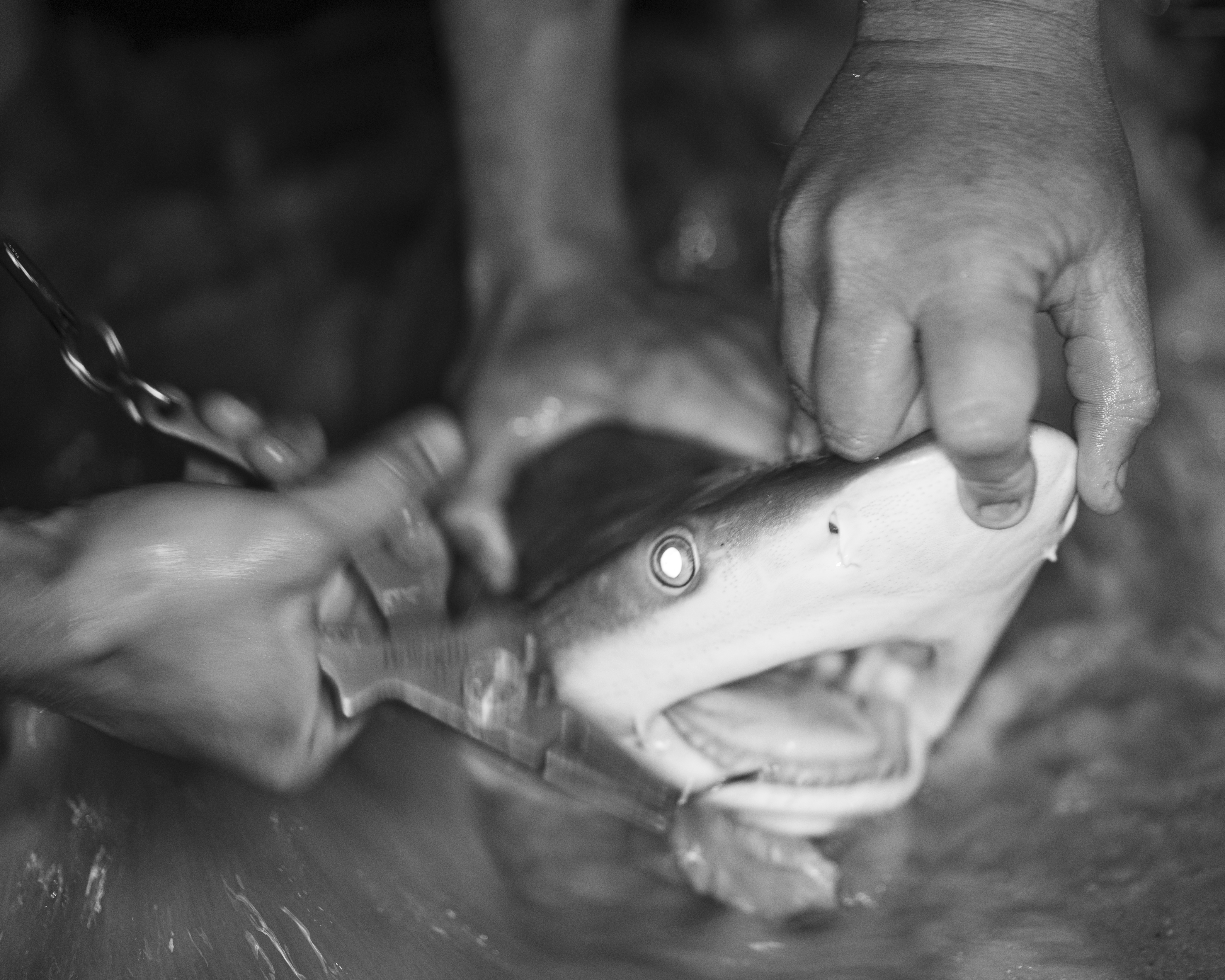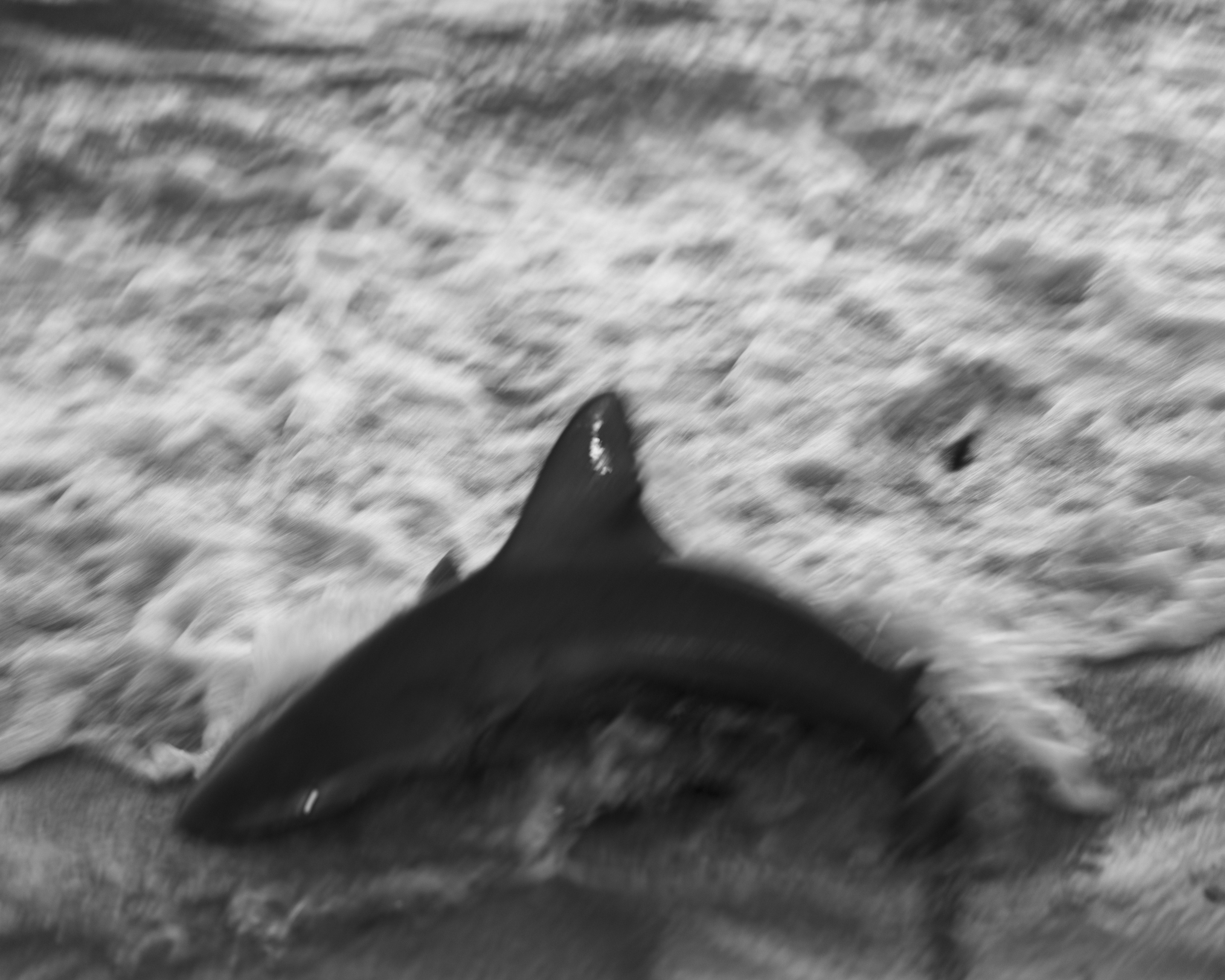 A
AA New Class of Oceanic Predator
The fishing poles danced along the horizon line of the open ocean, each tip fitted with a glow stick that began to glimmer as the sun slowly set. Dr. Keith Dunton and his team from Monmouth University prepared for a long night ahead. Although it was still June, a cold breeze blew in from across the water, indicating that the temperature would drop significantly once the sun went down. As the team was unpacking and getting their gear ready, one of the glow sticks began to move slightly quicker than the others. Something was on the line.
I started to unpack my camera gear frantically. Before I could make it to the surf, one of Keith’s students, a young marine biology student, made her way up the beach with what appeared to be a shark about a foot in length. A feeling of relief came over me as I was there to photograph sharks. With one shark already present, I began to feel good about the prospect of seeing more sharks in the night ahead. As I made my way to the shark to take a photograph, the student laid it down on a cooler and, in one quick motion, took off its head. The look on my face echoed around the group; one of the other students exclaimed: “That’s the bait, the sharks we will be catching are bigger… much bigger”.

We would be tagging and releasing several shark species in the evening ahead, with a special focus on sand tiger sharks. The species recently gained the ‘vulnerable’ conservation status. Like other species of shark, sand tiger sharks are threatened by irresponsible fishing practices and their low reproductive rates. Furthermore, the rise of social media has increased the trend of land-based shark fishing, as many people set out to capture a photo next to the large oceanic predators. Even in catch and release situations, however, irresponsible and ignorant practices will most often lead to the death of a caught shark. Through their shark tagging work, Keith and his research laboratory team hope to acquire the hard data on post-release mortality and shed light on shark behaviour using state-of-the-art electronic tagging technology. In a best-case scenario, they hope the shark tagging data will help shape policy that will protect these endangered coastal carnivores.
When the sun was almost gone, one of the poles started to move frantically towards us. Everyone immediately prepared for the creature as it invisibly approached the shore. I waded into the water, hoping to get the iconic fin photo as it emerged from the surf. As the shark approached the beach, it appeared to be between six and seven feet in length. As I stood in the waist-deep water trying to take my shot, I realised the precarious situation: I was an out-of-place primate in the shark’s home court. Before I could process the danger or fear, the group of students had already moved into action, restraining the shark in the shallow water. Keeping a hand on the head of the shark, Danielle Dyson, one of the students, held her weight on the body to keep the shark from moving about in the waves as they washed in. With a well-choreographed dance of movement and communication, the team took vitals measurements and placed a pop-off archival satellite tag on the shark’s lower dorsal fin. As quickly as the shark came in, it was already being sent out. As the shark slipped into the darkness of the deeper water, its strong graceful body was silhouetted by the headlamps of the crew. Its dorsal fin circled across the surface for a moment before disappearing completely.



This is how the night would continue. Small talk interrupted by a new shark on the line, and the group would tag and release. With the consistency of the team’s performance, I was able to gradually get better photographs by way of getting closer and closer to my subjects. After our third catch, Keith showed me photographs of the fishing charters that bring tourists on overnight fishing tours to catch sharks. The Instagram accounts were littered with fully beached large sharks with grinning tourists standing nearby.
A conversation about the attraction humans have towards predators was interrupted by an out-of-breath, young man. His cut-off cargo shorts were soaking wet as he gathered himself. He began explaining that he and his friends caught a large shark about a quarter mile up the beach. A key part of the research study I was witnessing tonight, in addition to capture and release tagging, is to work with local fishermen to collect data on fishing methods they use and its effects on the caught sharks. Word traveled fast that the team was looking for sharks and the fishermen came to us.
The team was clearly ready for this event as the whole operation was picked up and taken down the beach to follow the fisherman. In what felt like a mad dash, we made our way down the beach. Immediately on the other side, we were greeted by an enormous shark. It had been dragged up onto dry sand and we couldn’t tell how long it had been sitting there. One of the students leaned over to me and said: “Unfortunately, this shark is probably not going to make it.” Sharks of this size are very heavy and their internal make-up is not built for the gravity that is felt outside of the water. Their internal organs become crushed under their own weight. The shark’s death could come days or even weeks later from the combination of organ failure and stress of the capture event. An apex predator in the water, these creatures become helpless slugs once on land.





As the night continued, the team’s tagging operations got interrupted by other fishermen with similar stories. Tagging, small talk, racing to a nearby fisherman… the night continued. After losing count of the sharks we saw, I felt the night coming to an end. The sun was set to rise within the next hour and the team was satisfied with the data they had collected for the evening. Bad gas station coffee helped me to make the long drive up the garden state parkway. The pink sun flickered along the water of the surrounding marshlands, silhouetting the Atlantic City skyline as it came up overhead. Reflecting on the night, I couldn’t shake the sight of seeing the sharks so stripped of their predatory power as they lay on the beach.
The desire for the ‘thrill’ of catching a shark and dragging it onto the beach to be photographed as a trophy made it clear that we are the predators now. As predators, we hunt for social capital and attention rather than subsistence. This can be seen far outside of the small example of the vulnerable species affected in the story at hand. Hopefully, the data collected by Keith and his team can help prevent more predatory practices on our part and, at best, protect these sharks from our lack of responsibility in our newfound position of power.
